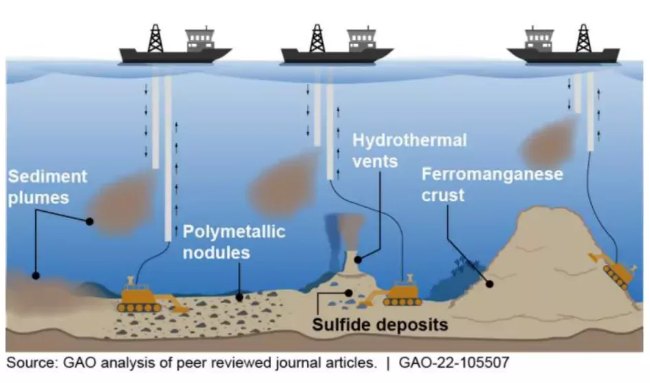Deep-Sea Mining: Trump’s Push for Critical Minerals Ignites Gold Rush

Deep-sea mining is rapidly emerging as a controversial opportunity to access critical minerals from the ocean floor. Fueled by the Trump administration’s recent executive order, this initiative aims to expedite the extraction of polymetallic nodules saturated with essential metals such as cobalt and nickel. As the global demand for these resources intensifies—partly due to the technological shift towards greener energy solutions—concerns about the environmental impact of mining operations have heightened. The geopolitical dynamics surrounding seabed mining are also evolving, as nations like the U.S. seek to diminish reliance on countries like China for mineral supplies. Ultimately, this deep-sea gold rush could redefine both resource extraction practices and international relations in the coming years.
The extraction of resources from the oceanic depths, often referred to as marine mining or seabed resource utilization, has become a focal point in resource management discussions. This promising yet contentious practice targets valuable deposits such as polymetallic nodules, which are rich in critical minerals essential for modern technology. In the current climate of global resource competition, especially in the context of the Trump administration’s push for accelerated mining efforts, the implications for both ecological sustainability and geopolitical stability are profound. While some advocate for this method as a solution to decrease terrestrial mining impact, others express grave concerns about its potential environmental repercussions. As countries navigate these intricate issues, the balance between securing essential mineral resources and protecting marine ecosystems remains a critical challenge.
The Rise of Deep-Sea Mining and Critical Minerals
The deep-sea mining industry is rapidly gaining momentum, particularly in light of the recent policies introduced by the Trump administration. This surge is primarily motivated by the urgent demand for critical minerals, which are essential for technologies ranging from renewable energy solutions to advanced defense systems. These include cobalt, nickel, copper, and manganese, all of which can be abundantly found in polymetallic nodules on the ocean floor. As countries scramble to secure these resources, the push for deep-sea mining could transform the mineral supply landscape, reducing reliance on traditional terrestrial mining, which often has significant environmental costs.
The geopolitical implications are equally profound. Notably, the Trump administration’s executive order signifies a strategic move to counterbalance China’s influence over global mineral supply chains. As the U.S. looks to exploit these underwater resources, nations and corporations across the globe will be prompted to reassess their positions in the critical minerals arena. This could lead to increased competition for mineral rights and enhanced collaboration or tension among nations concerning environmental regulations and resource management in international waters.
Geopolitical Dynamics Shaping Deep-Sea Mining Policies
The geopolitical dynamics associated with deep-sea mining are largely characterized by the United States’ aggressive stance in the wake of the Trump administration’s recent executive order. By prioritizing the acceleration of mining activities, the U.S. aims to not only boost its domestic manufacturing capabilities but also to challenge China’s dominance in mineral production. This unilateral approach has raised eyebrows internationally, especially among member states within the International Seabed Authority (ISA), which oversees seabed mining regulations. Critics argue that such actions could destabilize the cooperative governance framework that the ISA seeks to establish.
Furthermore, the reaction from China’s foreign ministry underscores the potential for escalating tensions. Their condemnation of the U.S. order as a violation of international law reflects a broader concern about the implications of unilateral actions on collective global interests. As nations consider the possibility of their own deep-sea mining initiatives, the balance of power in mineral resource control is likely to shift, creating a complex interplay of alliances and competitions in the quest for critical minerals.
Environmental Concerns Surrounding Deep-Sea Mining
While the prospect of deep-sea mining presents numerous economic opportunities, the environmental ramifications are a pressing concern. Critics argue that excavating polymetallic nodules from the ocean floor poses significant risks to marine ecosystems, which are still poorly understood. Advocates for responsible mining practices emphasize the importance of a thorough environmental impact statement to mitigate potential ecological damage. Industry leaders like Gerard Barron of The Metals Company emphasize their commitment to minimizing environmental disruption, but skeptics worry that assurances may not be enough to safeguard precious marine habitats.
Scientific studies indicate that the ecological effects of seabed mining could be long-lasting and far-reaching. Proponents of mining may highlight its potential to lessen reliance on land-based mining, but opponents like Danielle Fugere argue for a cautious approach, seeking regulatory frameworks that prioritize sustainability and ecological preservation. As the deep-sea mining initiative progresses, it will be critical to address these environmental concerns transparently, ensuring that economic gains do not come at the expense of marine health.
The Role of the International Seabed Authority (ISA)
The International Seabed Authority (ISA) plays a vital role in regulating seabed mining activities, especially in international waters where much of the mineral wealth resides. While the U.S. has opted for a more aggressive, unilateral approach under the new executive order, the ISA maintains that its framework is essential for protecting the interests of all nations and the marine environment. This could lead to significant legal battles over compliance and jurisdiction as companies, including U.S.-based entities like The Metals Company, seek to navigate both domestic policies and international regulations.
Additionally, the ISA’s ongoing efforts to establish a comprehensive mining code are crucial as they aim to balance the need for mineral extraction with environmental stewardship. The authority has indicated that a regulatory agreement may be within reach by the end of 2025, though skepticism persists within the industry regarding the timeline and feasibility of such frameworks. As the landscape of deep-sea mining evolves, the ISA’s role as a mediator between advancing mineral exploitation and protecting shared ocean resources will become increasingly significant.
Investor Interest in Deep-Sea Mining Initiatives
The announcement of the Trump administration’s executive order has catalyzed a surge in investor interest in deep-sea mining initiatives. Investors are drawn to the potential profitability tied to the extraction of critical minerals found in polymetallic nodules, particularly as the global economy moves towards green technologies and sustainable energy. Following TMC’s application for a commercial license, there’s a growing buzz in the investment community, signaling a shift in how minerals are perceived as valuable assets crucial for future advancements.
The interplay between investor enthusiasm and regulatory clarity will be pivotal for the industry’s future. As companies like The Metals Company promise minimal environmental impacts, investors will closely monitor the development of mining projects and the responses from environmental watchdogs and governments alike. The legitimacy of these ventures hinges not only on their economic viability but also on their ability to comply with environmental standards and avoid escalating conflicts over mineral rights on the high seas.
The Future of Critical Minerals in a Changing Economy
As the global economy shifts towards renewable energy and high-tech innovation, the demand for critical minerals is set to increase dramatically. These vital resources are essential for manufacturing batteries, solar panels, and other cutting-edge technologies that underpin sustainable development. The push for deep-sea mining could play a crucial role in meeting this growing demand, especially as land-based supplies become scarcer or are increasingly opposed due to environmental concerns.
However, navigating the transition to a new mineral economy will require comprehensive strategies that include not just extraction but also recycling and sustainable use of materials. The focus on deep-sea mining emphasizes the critical need for a holistic approach that balances the simultaneous goals of economic growth and environmental stewardship. As stakeholders across the globe consider how to attain critical minerals sustainably, the choices made today will significantly influence the health of our oceans and the future of our technological landscape.
Advancing Technology and Deep-Sea Mining Practices
Recent advancements in technology have revolutionized the deep-sea mining process, making it more efficient and less invasive. Companies are now utilizing specialized machinery designed to extract polymetallic nodules without causing excessive damage to the surrounding seabed. This technological evolution aligns with the industry’s push for more environmentally responsible practices, aiming to mitigate the ecological footprints of mining operations while maximizing output efficiency.
Innovative technologies not only enhance extraction methods but also improve monitoring capabilities, allowing for real-time assessments of environmental impacts. This is crucial as stakeholders, including investors and regulatory bodies, demand greater transparency in deep-sea mining initiatives. The industry must continuously adapt to incorporate these advancements while also addressing the substantial environmental concerns associated with seabed mining—balancing profitability with responsibility will be key to ensuring sustainable practices in the long term.
Legal Challenges and the Future of Deep-Sea Mining
As the race intensifies for critical minerals in the depths of the ocean, legal challenges loom on the horizon. The U.S.’s unilateral approach to fast-tracking deep-sea mining raises questions about compliance with international laws, particularly given its non-participation in the U.N. Convention on the Law of the Sea. Legal experts are already anticipating disputes between nations and companies regarding mining rights and environmental responsibilities, which could undermine the collaborative spirit necessary for managing global marine resources.
Moreover, the ongoing discussions by the ISA regarding the establishment of a cohesive regulatory framework for seabed mining will be scrutinized in international courts as nations weigh their sovereignty against global norms. As mining companies advance their interests in the ocean floor, they must navigate an increasingly complex legal landscape that balances the need for resource extraction with adherence to international agreements designed to protect marine environments and uphold collective global interests.
Perspectives from Environmental Advocates on Mining Initiatives
Environmental advocates express grave concerns regarding the implications of deep-sea mining initiatives. Critics like Danielle Fugere raise alarms about the potential for irreversible damage to marine ecosystems that are already vulnerable. The exploration and exploitation of polymetallic nodules may disrupt delicate underwater habitats, posing a risk to biodiversity that has not been sufficiently studied. These voices emphasize the importance of robust environmental assessments and regulatory oversight to ensure that mining activities do not escalate into ecological disasters.
This pushback from environmental organizations highlights the critical need for transparency and accountability in the mining process. As companies develop their plans for extraction, engaging collaboratively with environmental scientists and advocacy groups will be vital to finding solutions that honor both economic goals and conservation efforts. As debates around the sustainability of deep-sea mining continue, the outcome will hinge on the industry’s willingness to prioritize ecological considerations alongside mining ambitions.
Frequently Asked Questions
What is deep-sea mining and why is it important for critical minerals?
Deep-sea mining is the process of retrieving minerals from the ocean floor, particularly targeting polymetallic nodules, which are rich in critical minerals such as cobalt, nickel, copper, and manganese. These minerals are essential for various industries, including technology and renewable energy, making deep-sea mining a vital component in addressing global demand.
How does the Trump administration’s executive order impact deep-sea mining?
The Trump administration’s executive order aims to expedite deep-sea mining activities in the U.S. and international waters, facilitating private companies in accessing vast resources of polymetallic nodules. This move seeks to reduce reliance on foreign mineral supplies, particularly from China, and stimulate domestic manufacturing.
What are the environmental impacts of deep-sea mining?
The environmental impact of deep-sea mining is a major concern, as the process can disrupt marine ecosystems and biodiversity. Critics warn that the long-term ecological effects remain unpredictable, emphasizing the need for careful regulatory oversight to mitigate potential damage resulting from harvesting specific minerals.
How does deep-sea mining affect geopolitical dynamics?
Deep-sea mining is reshaping geopolitical dynamics as countries vie for control over critical mineral resources. The U.S. push for deep-sea mining under the Trump administration could encourage other nations, particularly those involved with the International Seabed Authority (ISA), to seek a unified mining code, potentially altering international relations and mineral resource distribution.
What role does the International Seabed Authority play in regulating deep-sea mining?
The International Seabed Authority (ISA) serves as the legal authority overseeing deep-sea mining activities in international waters. The ISA’s regulations are designed to establish a framework for sustainable extraction of polymetallic nodules while ensuring compliance with international laws and protecting marine environments.
Why is there controversy surrounding deep-sea mining?
The controversy surrounding deep-sea mining stems from a clash between economic interests and environmental protection. Critics cite legal violations, environmental degradation risks, and potential repercussions for marine life, raising concerns about the sustainability of mining practices pushed by initiatives like those from the Trump administration.
What are polymetallic nodules and where are they found?
Polymetallic nodules are potato-sized mineral deposits found on the ocean floor, primarily composed of critical minerals such as nickel, copper, cobalt, and manganese. They are typically located in deep-sea habitats and represent a potential resource for meeting global mineral demands, particularly in technologies that rely on these metals.
How does deep-sea mining relate to the demand for green technology?
Deep-sea mining is increasingly relevant to the demand for green technology, as critical minerals extracted from polymetallic nodules are essential for producing batteries, renewable energy systems, and other sustainable technologies. This emerging industry is seen as a way to diversify supply chains and reduce environmental impacts associated with traditional terrestrial mining.
What are the implications of the United States not ratifying the U.N. Convention on the Law of the Sea in relation to deep-sea mining?
The U.S. not ratifying the U.N. Convention on the Law of the Sea complicates deep-sea mining efforts, as it limits U.S. participation in international agreements governing ocean resource exploitation. This absence challenges collaboration on sustainable mining practices and raises concerns about unilateral actions that may undermine global marine conservation efforts.
What steps are companies taking to ensure minimal environmental disruption during deep-sea mining operations?
Companies like The Metals Company emphasize their commitment to minimal ecological disruption by preparing environmental impact statements and implementing strategies designed to safeguard marine ecosystems during deep-sea mining operations. These measures aim to demonstrate responsibility and compliance with environmental standards amidst growing scrutiny.
| Key Point | Details |
|---|---|
| Executive Order | Trump administration’s order to expedite deep-sea mining to counteract China’s mineral resource dominance. |
| Polymetallic Nodules | Rich in critical minerals like cobalt, nickel, copper, and manganese, these nodules are the target of deep-sea mining. |
| Geopolitical Implications | The move may alter geopolitical relations and encourages other countries to push for a mining code in the ISA. |
| Environmental Concerns | Critics warn that the ecological impact of seabed mining is still unpredictable, raising concerns for marine life. |
| Regulatory landscape | The U.S. has not ratified the U.N. Convention on the Law of the Sea, complicating international compliance. |
Summary
Deep-sea mining represents a burgeoning frontier in resource extraction, catalyzed by recent initiatives under the Trump administration aimed at securing critical minerals needed for various industries. With the potential to unlock vast reserves of polymetallic nodules from the ocean floor, the implications of this drive extend beyond economic interests, igniting debates around environmental protection and international law. As the pursuit of deep-sea mining accelerates, it is crucial for stakeholders to balance resource development with sustainable practices to safeguard marine ecosystems.




